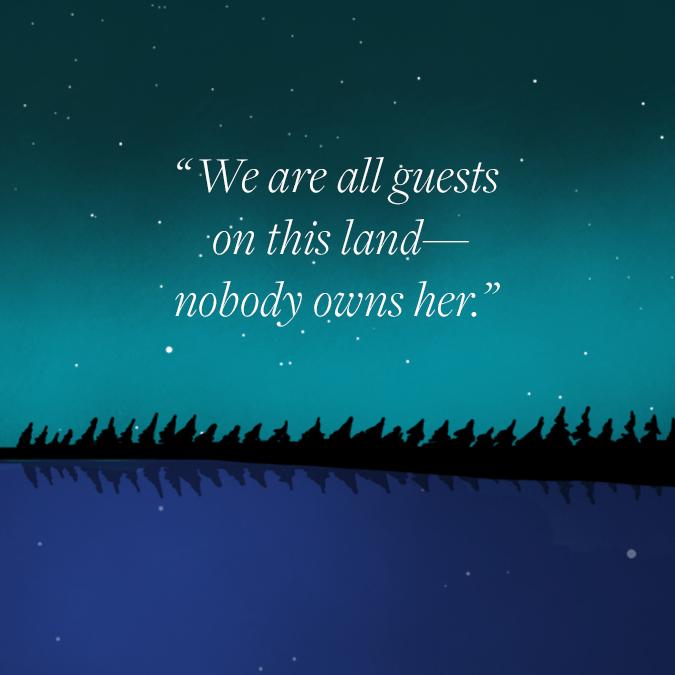 Looking Closer
Looking Closer
Before moving on, watch Treaties 101 to help you better understand the basics of what is involved with treaties.

Let's start off by addressing a common misconception when it comes to treaties in Canada.
Many people think of treaty rights as "special" Indigenous rights. However, all people living in Canada are treaty people with their own set of rights and responsibilities. Treaties are a foundational part of society in Canada. Every road, house, building or business, and settlers' existence on this land as 'Canadians', exists today because a Treaty made it possible. It is important to know the Treaty Rights of those where you tend to do business. Most Canadians do not know the legal obligations of treaties prior to taking on a project and think it's just an interaction of the Crown and First Nations groups. That is not the case.
In the context of treaty negotiation with Indigenous Peoples, understanding the fundamental principles related to treaties is essential for fostering meaningful and respectful engagements between different parties.
These principles are deeply rooted in Indigenous laws, worldviews, and relationality and provide valuable insights into the dynamics of treaty-making. One crucial aspect is the recognition of the existence and legitimacy of Indigenous Peoples' sovereignty and self-governance, which has existed for time immemorial (i.e., long before settlers arrived). Each nation comprises diverse societies with distinct identities, which is significant in acknowledging their unique Rights, values, and perspectives. Moreover, oral traditions play a vital role in treaty negotiation, serving as accurate and skillfully crafted methods of recording information. These traditions pass on crucial cultural knowledge from one generation to the next, often offering alternative viewpoints to settler-recorded accounts.
Embracing Indigenous ways of knowing and being (e.g., oral knowledge) more appropriately situates settlers to follow the legal expectations set on them as Treaty people, laying the groundwork for genuine partnerships built on mutual respect and understanding.
Let's look at a couple of essential aspects in more detail.
These traditional foundations in treaty negotiation are important because they form the very essence of Indigenous identity, relationships with the land, and an important aspect of history. As much of what we call 'Canada's land is overlaid by various Treaties, making all of its inhabitants responsible to their Treaty obligations, these foundations are relevant to everyone who calls this land home. Understanding these principles is essential to approach Treaty Rights with respect and sensitivity, acknowledging the unique perspectives and needs of each Indigenous community.
First Peoples' Sovereignty: Recognizing that Indigenous communities were sovereign and self-governing before Settler contact affirms their inherent rights and authority over their lands and resources. This principle acknowledges the significance of Indigenous self-determination, ensuring Indigenous Rights holders participate as equal partners in treaty negotiations.
Distinct First Nations: Understanding that First Nations are distinct and diverse from one another respects their unique cultures and the significance of their individual histories. In treaty negotiations, this awareness allows for tailored agreements that address the specific needs and aspirations of each First Nation, fostering inclusivity and fairness.
Pre-Contact Agreements and Treaties: Acknowledging the existence of pre-contact agreements and treaties underscores the longstanding diplomatic practices of Indigenous peoples. It emphasizes the ability to form agreements and partnerships, affirming the long-standing sovereignty and autonomy over Indigenous territories.
By recognizing and valuing these foundations, settlers engaging and/or consulting with Rights holders can aim for a meaningful and constructive approach. These foundations provide a framework for building relationships based on mutual respect and understanding, promoting dialogue that upholds Indigenous rights and promotes equitable partnerships between Indigenous communities and other governing entities. Embracing these principles is crucial in advancing [re]conciliation and moving towards a shared vision of cooperation, coexistence, and a sustainable future for all.
The significance of oral history in treaty negotiation is vital as it sheds light on Indigenous Rights, knowledge, values, perspectives, cultures, and the long-term context of agreements. In terms of treaty-making, here are some key reasons as to why oral history is important:
Accurate and Skillful Recording: Oral traditions serve as accurate and skillfully crafted methods of recording information. Passed down through generations, these narratives hold valuable insights into Indigenous histories, customs, and relationships with the land. They preserve ancient wisdom, making oral history a reliable source of cultural knowledge.
Cultural Transmission: Oral traditions play a critical role in passing on important cultural knowledge from one generation to the next. Through storytelling, ceremonies, and songs, Indigenous communities share their teachings, values, and experiences, fostering cultural continuity and identity.
Alternative Perspectives: Oral records of treaties made between First Nations and Europeans often offer different perspectives compared to the written records. These accounts provide unique insights into the intentions, agreements, and understandings from Indigenous viewpoints, enriching the understanding of treaty history.
Evidence in Legal Cases: In the legal context, oral history holds weight as evidence in important court cases, supporting Indigenous land and treaty rights claims. Recognizing oral history as valid evidence acknowledges the validity and integrity of Indigenous storytelling and cultural memory.
Acknowledging the importance of oral history means that treaty negotiations can center Indigenous knowledges, narratives, values, wisdom, and perspectives, leading to more comprehensive and respectful agreements – including agreements that can withstand legal challenges. Moreover, valuing oral history contributes to a more balanced record and a deeper appreciation for the diverse cultures of Indigenous peoples. It fosters trust and mutual understanding, creating a foundation for collaborative and meaningful treaty relationships.
 Looking Closer
Looking CloserBefore moving on, watch Treaties 101 to help you better understand the basics of what is involved with treaties.
Of course, there are treaty and territory overlaps. This is because of the following:
I recommend you embrace treaty or territory overlap and work with all communities to identify issues and accommodate them the best you can. The supreme court of Canada has ruled that Indigenous communities must work out their differences together to have a conflict resolution. Prior to issuing a statement of acceptance
- Gary Pritchard
Treaty or territory overlap is a complex and significant aspect that emerged due to circumstances and the interaction between Indigenous Nations and settlers. The presence of overlapping territories can be attributed to various factors, as outlined below:
Community Boundaries and Traditional Territories: Before European contact, Indigenous communities had well-defined boundaries that extended into each other's territories. These boundaries were based on Indigenous knowledge, shared histories, and the use of the land for various purposes, such as hunting, fishing, and gathering. As treaties were negotiated with European settlers, the complexities of these pre-existing boundaries were rarely understood or accounted for.
Crude Mapping and Documentation: During the treaty-making process, settlers brought with them rudimentary methods of mapping and documentation. These techniques often lacked the precision needed to capture the intricate details of Indigenous territories accurately. As a result, some treaties inadvertently led to overlapping claims or ambiguities regarding land ownership and use.
It is crucial to acknowledge and embrace treaty or territory overlap as it reflects the complexities of the long-term relationships between Indigenous nations and the Canadian government. Rather than viewing overlap as a problem, it can be an opportunity for cooperation and collaboration.
 Stop and Reflect
Stop and Reflect What might be some other benefits to taking a collaborative and problem-solving-focused approach to the issue of Treaty of Territory Overlaps that have not been mentioned above? Take a moment to gather your ideas and then click on Some thoughts below and compare your ideas.
Some thoughts
Recognizing and accommodating treaty or territory overlap, we can build stronger relationships, foster reconciliation, and promote a deeper understanding of the land's significance to Indigenous peoples. Embracing this approach is a step towards honoring the treaties and acknowledging the histories and connections of Indigenous communities, contributing to a more just and equitable future for all.
The goal for land claim negotiations as part of the treaty process is to provide jurisdiction and resolve ambiguity over the ownership and use of land and resources. A treaty will codify the rights and obligations of the parties.
However, if there is an existing treaty within the claim, there must be a negotiation period between the existing treaty holders and the new parties.
In the context of Indigenous rights and land governance, understanding the distinction between land claims and treaties is essential. Both processes are crucial to recognizing and resolving historical grievances related to land ownership and resource use.
Let's explore some key differences:
Land Claim Negotiations: Land claims are legal and political processes through which Indigenous communities assert their rights and interests over specific territories that may have been subject to past dispossession or inadequate recognition. The goal of land claim negotiations is to address historical injustices, provide jurisdictional clarity, and resolve ambiguity over land ownership and resource rights. Through these negotiations, Indigenous communities seek to reclaim traditional territories and secure acknowledgment of their inherent rights to govern and use the land sustainably.
Treaty-Making Process: Treaties, on the other hand, are formal agreements established between Indigenous nations and the Canadian government. Historically, treaties were made as part of the process of European settlers seeking land and resources in Indigenous territories. The treaties, often made in written form, outline the rights and obligations of both parties, including land cessions, promises of protection, and provisions for education and healthcare.
Interplay Between Land Claims and Existing Treaties: A significant aspect to consider is the interplay between land claims and existing treaties. In some cases, there may already be treaties in place with certain Indigenous communities, while others are pursuing land claims in the same region. When an Indigenous group asserts a land claim within the territory covered by an existing treaty, there must be a negotiation period between the parties involved. This period allows for discussions to determine how the rights and interests of all parties can be accommodated and respected.
Addressing the complexities of land claim negotiations and the coexistence of existing treaties requires open communication, understanding, and a commitment to reconciliation. By honouring the treaties and engaging in respectful negotiations, it becomes possible to build a future where Indigenous communities can reclaim their rightful place in the governance of their traditional lands, preserve their cultural heritage, and sustainably manage the resources for generations to come. Embracing this process is a significant step towards forging meaningful partnerships and fostering greater respect for Indigenous rights and self-determination.
Historic treaties were largely negotiated orally and written down by the Crown from the Crown's perspective. The Crown wrote some down in advance before oral negotiations.
Many (if not most or all) Indigenous signatories to the treaties understood the treaty agreements as being the foundation of a relationship with the Crown and that this relationship would be based on co-existence and sharing the land and its resources.
 Looking Closer
Looking CloserBefore moving on, watch Aboriginal Rights as Economic Rights: Whose land is Canada selling? Lecture by Arthur Manuel to help you gain a different perspective on issues around the use of land, as it is impacted by treaties and treaty negotiation.
Another important issue relating land and economics is the idea of stolen wealth. Watch The Indian Trust Fund to learn more about how issues of land disposition and dependency became a serries issue and ongoing issue.
Of course, the Crown's understanding of those treaties is what was recorded in writing and thus has become the dominant settler view. From the Crown's perspective, most historic treaties stand for the complete surrender of land with only a small reserve retained and (in most cases) limited rights to hunt, fish, and trap in the surrendered territories.
 Looking Closer
Looking CloserAs noted, many are familiar with Crown understanding of treaties and the treaty processes. Before moving on, watch In Our Words- Understanding Treaties to learn about what treaties mean from our perspective.
One way of understanding what it means when someone says they want to "renew the treaty relationship" or that they want the government to "fulfill the treaties" is to think about how First Nations understood the historic treaties at the time they were signed. For many decades, First Nations who signed historic treaties have called for the Crown to re-establish the relationship of nation-to-nation co-existence and sharing the land and resources.
For historic treaties, looking at the written treaty document alone – written in English by the Crown, from its own perspective – is often unhelpful because the written text may not have captured the true oral agreement. When interpreting and implementing a contract, the perspectives of both parties need to be taken into account. Treaties are no different in this respect. Treaties are not a handshake or a handout. They are binding, reciprocal commitments. Neither party can unilaterally withdraw from the treaty or change its terms.
 Stop and Reflect
Stop and ReflectIn Wab Kinew's video Understanding Reconciliation: Mere co-existence, New Foundation, or Mutual Celebration?, we are offered a number of different perspectives on what moving forward might look like. What do you think of his message? More specifically:
After you have gathered your ideas, click on Some thoughts below and compare your responses to three different perspectives on Mere Co-existence, New Foundation, and Mutual Celebration.
Some thoughts
Mere Co-existence: Acknowledging mere co-existence, while better than open conflict, falls short of addressing the historical injustices and systemic issues faced by Indigenous communities in Canada. It can be argued that true reconciliation requires a more proactive and intentional effort to address the legacy of colonization, colonialism, assimilation, and marginalization faced by Indigenous peoples.
New Foundation: The "New Foundation" approach advocates for fundamental changes in the relationship between Indigenous and non-Indigenous peoples. It can be argued that reconciliation must involve reshaping the very foundations of Canadian society to incorporate Indigenous perspectives, recognize Indigenous rights, and promote self-determination for Indigenous communities. This approach involves addressing issues such as land rights, education, healthcare, and the recognition of treaties.
Mutual Celebration: The "Mutual Celebration" can be seen as a positive step towards reconciliation. It could be argued that it emphasizes the importance of celebrating Indigenous cultures, traditions, and contributions to Canada as a means of fostering understanding, respect, and unity. However, there is a caution that mutual celebration should not be a substitute for substantive actions to address historical and ongoing injustices, as true reconciliation requires concrete changes and efforts to address the disparities faced by Indigenous peoples.
While some Indigenous and non-Indigenous peoples call for the removal of the Act, some people fear that its removal would erode certain protections, such as those on Indian Status. The Act provides the structure for local community governance and community life. Removing or reforming the Act in one fell swoop would be enormously disruptive to First Nations' ways of life.
Some Indigenous peoples hope that the powers of the Act will shift focus to move towards self-government and reconciliation, contributing to a change in government-Indigenous relations.
Though the Act has been amended several times over the years, the contemporary version still outlines the terms of Indian Status, various rules around reserves, financial guardianship of minors, management of band resources, elections, and other aspects of life on a reserve.
The Act has had ongoing and long-lasting impacts on Indigenous cultures, economies, politics, and communities. It has also caused inter-generational trauma, particularly concerning residential schools, as the oppression and restrictive provisions have negatively impacted generations of Indigenous peoples.
The Indian Act holds significant implications for treaties and treaty-making in Canada. While opinions vary on whether it should be entirely removed or reformed, it remains a critical piece of legislation governing Indigenous peoples' lives. As Indigenous communities strive for self-government and reconciliation, they seek a shift in the Act's powers to empower Indigenous governance and cultural revitalization. However, the Act's cascading impacts on Indigenous cultures, economies, and communities cannot be overlooked, as it has caused, and continues to cause, enduring intergenerational trauma. Moving forward, striking a balance between preserving certain protections while advancing Indigenous self-determination will be crucial in fostering genuine and meaningful reconciliation between Indigenous peoples and settlers in Canada.
Canada was formed with the shared promises of peace, friendship, and mutual respect with First Nations in the presence of all of creation. These promises, for as long as the sun shines, the rivers flow and the grass grows, are to be in effect for peoples now and for those yet unborn. The challenges now faced by First Nations peoples and by all of humanity with the declining state of our natural world were not meant to be. Think of how enriched Canada and the world can be as Canada fulfills on its original promises of peace and sharing with First Nations peoples.
—National Chief Perry Bellegarde
National Chief Perry Bellegarde (in 2018) was urging all Canadians to open their hearts and minds to understand our shared history and look ahead to where we need to go together. Honouring promises, an essential component in real reconciliation, takes collective effort and action.
It starts with a commitment to Mother Earth, to our natural world, to the air and the water. For generations, we have heard promises. Now, we must see action in partnership with Indigenous knowledge systems. We must develop a vision of environmental stewardship that is global and holistic, taking us beyond existing targets and timelines toward a sustainable future for all generations. This includes our promise for progress and economic priorities that protect Mother Earth. We must mutually share and benefit from these lands.
Without this, our future does not look promising.